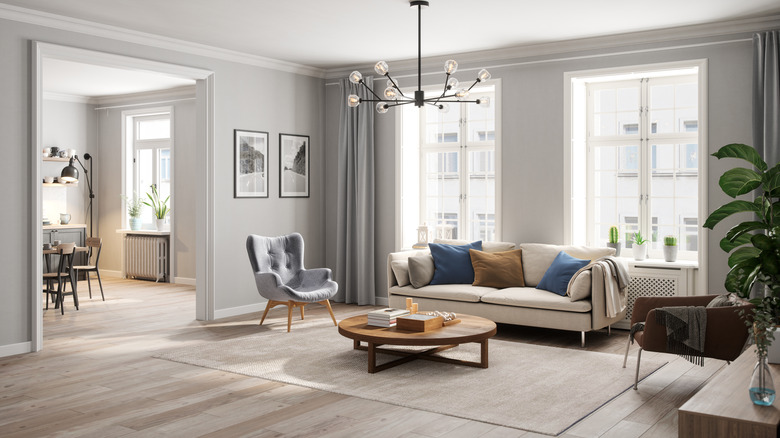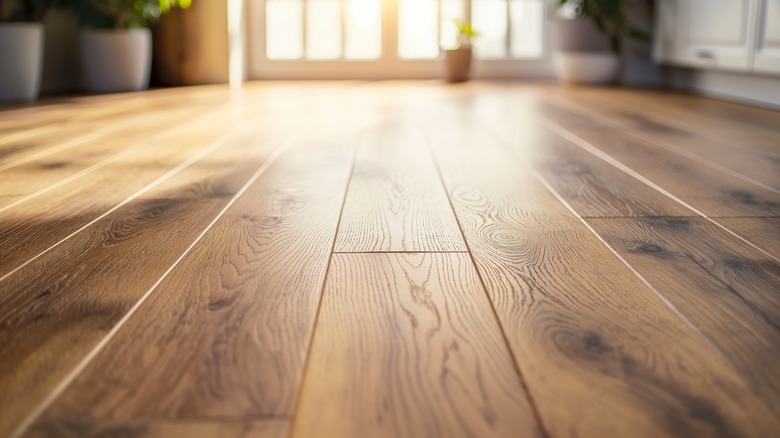The Property Brothers' Tips For DIY Flooring That Looks Good
If you want to completely transform the look and feel of your home's interior, upgrading your flooring is the best way to do it. Installing new floors in your home will not only help elevate its appearance, durability, and safety but it can also help increase the resale value of your home. But where do you start? As with any home reno project, there are always dozens of choices to be made along the way. For example, should you DIY your floor installation or hire professionals? If a DIY flooring installation is on your to-do list, HGTV home renovation pros Drew and Jonathan Scott from HGTV's Property Brothers have two expert tips to get you started.
When choosing the best flooring options for your home, Jonathan recommends that you avoid choosing more than two types of flooring that would be visible from any one point in your home. For example, if you want to install luxury vinyl plank flooring throughout your main living space and then use tile flooring in your guest bathroom and laundry room that are both just off that living area, consider choosing the same tile for those two rooms for a more cohesive look. The second tip from the HGTV stars is to stagger your flooring when it's time for installation for durability and a more professional look. Let's explore these tips a bit further.
Why you should avoid installing more than two types of flooring within close proximity
Home renovations are truly not for the faint of heart. They often (most definitely) require a lot of planning and having the ability to visualize the finished space before you start the project(s). Unfortunately, a common faux paus homeowners tend to make when choosing new flooring for their home — especially if doing it room by room over time — is choosing a different floor type for each room without considering the aesthetic of the whole house or how it may look next to adjacent rooms. For example, when homeowners Bob and Denise recruited the Property Brothers to help update their forever home (Season 6, Episode 12, "Finding a Positive Balance"), one of the first things the Property Brothers stars noticed was the home's outdated wood floors combined with nearby carpet and tile flooring. "I have a rule: You should never see more than two types of flooring from any one place in your home," Jonathan says. In this case, they opted to install luxury vinyl flooring across the main living areas for a cohesive and consistent look.
Overall, when you mix flooring types, you risk creating a visually overwhelming or a clashing interior. Try visualizing the entire space first, even if you're only renovating one room at a time. So, when it's time for you to start choosing your new flooring options or even a new hardwood floor color, keep the two-floor-type rule in mind for a smooth, professional, sophisticated appearance.
Staggering your floorboard seams: Why does it matter?
Staggering the floorboard seams of vinyl plank flooring, hardwood, and tile is key for your floors' longevity and visual appearance. To stagger your flooring during install simply means to place your floorboards in an unevenly-spaced pattern so the seams of adjacent rows do not line up. On Season 4, Episode 12 of HGTV's "Celebrity IOU", Jonathan comments, "It's so worth the extra couple of minutes that it takes to lay the boards out right, make sure none of the seams are lined up." This can be easier to achieve if your hardwood flooring comes in different sizes that would automatically prevent the seams from lining up. However, if the planks are all the same size (as vinyl plank flooring typically comes) you'll need to cut your vinyl planks to create this stagger effect — all you'd need is a sharp utility knife and the right measurements.
While adding an extra step to your floor installation may seem like a hassle, the downsides could end up costing you more time and money in the long run. "It's not smart to line up all your seams," Drew adds. "It doesn't secure the floor the same way." Not staggering your floorboards often leads to a visually unattractive look, unstable flooring, and even susceptibility of bowing or warping.
Here are two other things to keep in mind when staggering your floorboards: avoid placing the seams of adjacent rows any less than six inches apart; and, don't be afraid to mix and match planks from different boxes to bring a more natural look to your new floors. "Totally random is best," Jonathan recommends. Need even more tips to help prepare for DIY flooring? Check out these tips for a flawless vinyl plank flooring installation.


